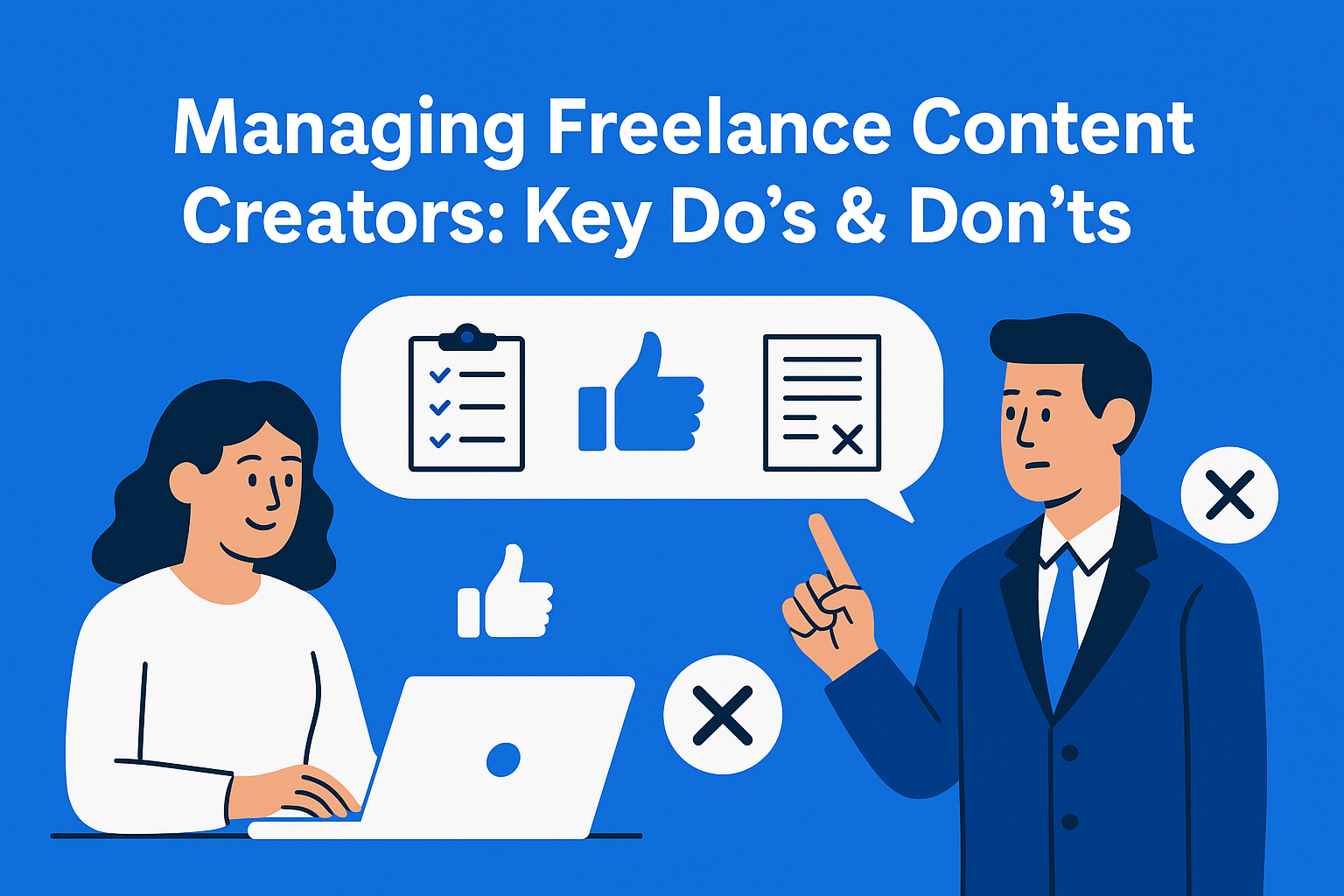The Do’s and Don’ts of Managing Freelance Content Creators
Discover the key do’s and don’ts of managing freelance content creators. Learn how to set clear expectations, communicate effectively, and build trust to get high-quality content, boost creativity, and grow strong, lasting collaborations.

Working with freelance content creators can be great, but also challenging - it all depends on how you manage them. They give you access to talent from all over the world, bring fresh ideas, and are often more flexible than full-time employees. But if you don’t manage them properly, you can quickly end up with delays, frustration, and content that’s just not good enough.
Here’s a list of what you should and shouldn’t do when managing freelance creators, and how to get the most out of your collaboration.
Key Takeaways
- Start with clarity - share a detailed brief (goals, audience, tone, word count, format, deadline) so you cut revisions later.
- Communicate early & often - lightweight check-ins and quick feedback prevent surprises; keep everything in one workspace.
- Trust their craft - give creative freedom within clear guardrails; invite fresh angles instead of dictating every line.
- Be fair and consistent - stick to scope and timelines, avoid last-minute pivots, and pay on time to build long-term trust.
- Reward great work - recognize wins publicly, offer bigger projects/bonuses, and support growth with tools and resources.
DO’s - What to Do
1. Set Clear Expectations From the Start
A solid project starts with clarity. Freelancers should know the essentials before they even begin - deadlines, word count, format, tone, and style. The more precise you are, the fewer back-and-forth edits you’ll need.
A good approach is to create a detailed content brief that they can reference from start to finish. If you’re using EasyContent, you can store the brief right in the platform, so there’s no need to search through old emails.
2. Communicate Regularly and Transparently
Silence is the enemy of a smooth project. Don’t wait until the submission date to check in. Instead, keep a light but steady flow of communication.
That might mean:
- A quick weekly update call
- Short messages on Slack or email
- Early feedback to correct direction before it’s too late
With EasyContent, you can handle all of this directly in the project workspace, so nothing gets lost.
3. Give Them Creative Freedom
Freelancers thrive when they feel trusted. Yes, you need structure, but avoid dictating every word. Share the end goal and guidelines, then let them find the path.
When they have the space to:
- Suggest topics
- Bring in new angles
- Add their own style
…you often end up with richer, more engaging content than you expected.
4. Recognize and Reward Good Work
Recognition keeps motivation high. Sometimes a simple “Great job!” is enough, but you can go further by:
- Publicly praising them on social channels
- Offering bigger or more interesting projects
- Providing bonuses for exceptional work
5. Be Consistent and Organized
Freelancers need stability to plan their workload. Changing deadlines, scope, or rules too often can quickly kill trust.
Define your process, set deadlines, and stick to them. Tools like EasyContent make it easy to keep everything in one place - from tasks and feedback to deadlines and approvals.
DON’Ts - What to Avoid
1. Don’t Micromanage
Hovering over every step crushes creativity and slows progress. Set the goals, deadlines, and main guidelines - then step back. You can still agree on 1-2 check-in points to stay informed without smothering them.
2. Don’t Leave Them Without Information
Sending only a title and expecting magic rarely works. Give them context:
- The “why” behind the piece
- Target audience details
- Examples of similar content you like (and why)
The more they know, the more accurate and on-brand their work will be.
3. Don’t Delay Payment
Nothing sours a freelancer's relationship faster than late payment. Pay on time, every time - it builds trust and ensures they’ll want to keep working with you.
4. Don’t Change Direction at the Last Minute
If scope changes mid-project, communicate it right away. Discuss:
- New deadlines
- Revised deliverables
- Any additional payment for extra work
This keeps the relationship fair and avoids frustration.
5. Don’t Ignore Their Expertise
You hired them for their skills, so let them use them. Instead of vague feedback like “This isn’t right,” explain what’s off, why, and how it could be improved (ideally with an example).
Getting the Most Out of Freelancers
Strong management is about more than just briefs and deadlines. Support your freelancers’ growth by:
- Sharing useful resources or courses
- Giving access to tools that make their work easier
- Including them in relevant training sessions
It’s a win-win: they improve their skills, and you get better-quality content.
Conclusion
Managing freelancers successfully comes down to clear communication, respect, and trust. Get those right, and your freelance team can become one of your most valuable assets - delivering content that’s better, faster, and more creative than you imagined.






